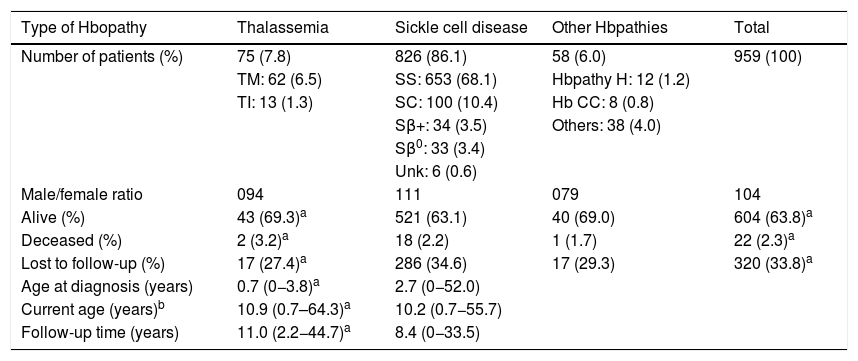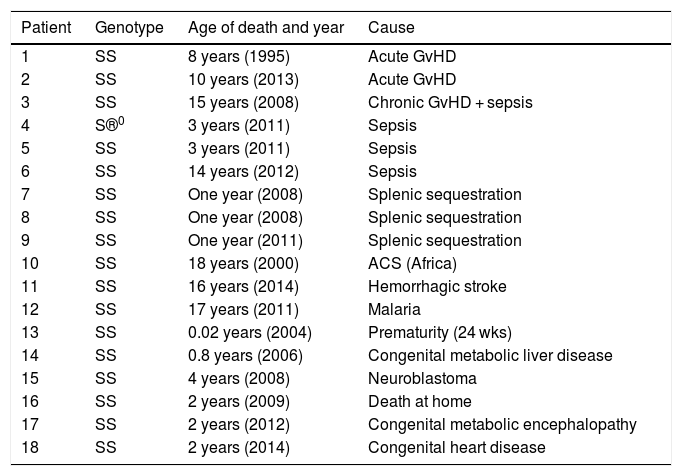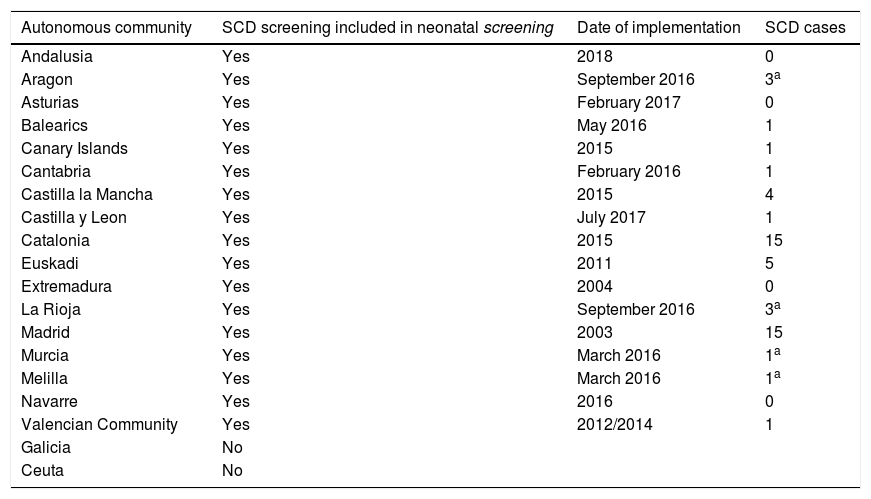Patients with thalassaemia major (TM) and sickle cell disease (SCD) in Spain have been counted since the creation of the Spanish registry of haemoglobinopathies (REHem). The objective of this paper is to update the published data after the increase in cases due to the inclusion of adults and introduction of new-born screening in almost the whole country.
Material and methodsAn observational, descriptive, multicentre and ambispective study that included patients with haemoglobinopathies registered in the REHem, started in January 2014 and followed up annually. The data presented correspond until December 31, 2017.
ResultsNine hundred and fifty-nine patients were collected. There were 75 cases of thalassaemia (62 TM), 826 of ECF and 58 of other types of haemoglobinopathies. The main diagnostic reason in the TM cohort was anaemia symptoms (70.6%), with a mean age at diagnosis of .7 years; in the SCD cohort it was neonatal screening (33.1%), with a mean age at diagnosis of 2.7 years; 26 patients with TM (41.9%) and 30 with SCD (3.6%) underwent a transplant.
There were 2 deaths (3.2%) with TM and 19 (2.3%) with SCD. Overall survival was 96.7% in the TM and 97.5% in the SCD cases at 15 years.
ConclusionsSince the previous publication and after the diffusion of new-born screening, the most frequent diagnostic method, to the majority of autonomous regions, and the inclusion of adult patients to the registry, the REHem has increased by more than 240 cases, reaching a total of 959 records.
Los pacientes con talasemia major (TM) y enfermedad de células falciformes (ECF) en España se han empezado a contabilizar desde la creación del registro español de hemoglobinopatías (REHem). El objetivo del trabajo es actualizar los datos publicados previamente, tras el aumento de casos por la inclusión de adultos y la introducción del cribado neonatal en casi todo el país.
Material y métodosEstudio observacional, descriptivo, multicéntrico y ambispectivo, que incluye pacientes con hemoglobinopatías registrados en REHem, iniciado en enero de 2014 y de seguimiento anual. Los datos presentados corresponden hasta el 31 de diciembre de 2017.
ResultadosSe recogieron 959 pacientes. Se registraron 75 casos de talasemia (62 T M), 826 de ECF y 58 de otro tipo de hemoglobinopatías. El motivo de diagnóstico principal en la TM fue la clínica de anemia (70,6%), con media de edad al diagnóstico de 0,7 años; en la ECF fue el cribado neonatal (33,1%), con media de edad al diagnóstico de 2,7 años; 26 pacientes con TM (41,9%) y 30 con ECF (3,6%) fueron sometidos a trasplante.
Hubo 2 fallecimientos (3,2%) con TM y 19 (2,3%) con ECF. La supervivencia global fue del 96,7% en la TM y de 97,5% en la ECF a los 15 años.
ConclusionesDesde la publicación previa y tras la difusión del cribado neonatal, el método diagnóstico más frecuente, a la mayoría de comunidades autónomas, y la inclusión de pacientes adultos al registro, el REHem se ha visto incrementado en más de 240 casos, llegando hasta un total de 959 registros.
Artículo
Comprando el artículo el PDF del mismo podrá ser descargado
Precio 19,34 €
Comprar ahora













